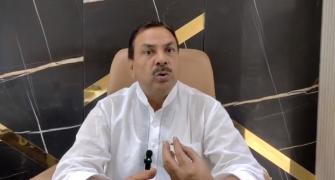Growth is like a drug, and it can kill like one, too. Reckless over-stretching to hit increasingly aggressive quarterly financial results -- at the expense of quality, even propriety -- has hobbled plenty of companies, large and small.
Which is why it's encouraging to come across a crowd of small-scale entrepreneurs who took a more disciplined approach to running their businesses -- and are prospering because of it. Like any small-business owner, this group runs on gumption and grit during the best of times, and embraces any imaginative means to survive in the worst.
What sets them apart? Among other things: a lineup of unique luxury products and services, lean staffs, obsession with quality, and the courage and conviction to do things their own way.
Could they stumble if the slump wears on? Absolutely. But with healthy order backlogs -- some stretching a few years out -- these five operations are safe for now.
Mike H. Stewart, 54
Labrador breeder, Oxford, Miss.
Owner and head trainer at Wildrose Kennels, Stewart deals only in English sporting Labradors in black, yellow, chocolate and fox red (a darker shade of yellow). He aims for what he calls "the 365 dog" -- patient and obedient in the field, loving and playful at home.
William Behnke bought a black male English Labrador Retriever named Ghillie from Wildrose Kennels in Oxford, Miss., three years ago. A business developer at GCI, an Alaskan telecom company, Behnke has hunted with Ghillie for pheasant in Montana, quail in Texas and ducks in his home state. He also brings the dog to his office in an Anchorage high-rise; together they attend business meetings and visit vendors. "He flies well, too, even in helicopters," says Behnke, who has never resorted to using a leash or a collar with Ghillie.
So taken is Behnke that he plans to fork over $12,000 for another Wildrose pooch named Opus, a male black Lab born in February. "I can't imagine being without dogs, and I can't imagine having dogs that are not well trained," he says. "Wildrose has given me both of those things."
The backlog for Stewart's new pups is 210 names deep, enough to keep this operation busy until 2010, and it is growing. Orders for puppies have climbed to 45 per month. Prices range from $1,275 for a black, yellow or fox red to $1,500 for a chocolate (the rarest type). Stewart also sells what he calls "finished" dogs -- those that have lived and trained at Wildrose for two to three years and have hunted 1,000-plus fallen birds. He has already sold out this year's allotment of 15 finished dogs and is taking orders for next year, at $10,000 to $12,000 apiece.
Five figures for a dog? Stewart points out that people spend four times as much for a car they'll dump in a few years. Raines Jordan, chief financial officer of Alexander Contracting in Columbus, Ga., agrees. Battered by the recession, he recently bought a fox red Lab named Ti. "I've lost a tremendous amount of what I've worked for in my life," he says. "I thought, hell, I might as well spend what's left on some enjoyment."
Sam Zygmuntowicz, 52
Luthier, Brooklyn, N.Y.
Zygmuntowicz is an artist's artist. He hews exquisite string instruments out of spruce, ebony and maple. "There are no more than six people who are at his level," says Tim Q. Ingles, director of musical instruments for Sotheby's.
In 2003, a violin built by Samuel Zygmuntowicz for Isaac Stern sold for $130,000 at auction, the highest price for one by a living luthier. Last year, Yo-Yo Ma played a $90,000 Zygmuntowicz cello on a two-month tour.
While routinely putting in 15-hour days, Zygmuntowicz makes only half a dozen instruments a year. His waiting list stands at 30, a comforting five-year backlog. He charges roughly $53,000 for a new violin and $90,000 for a cello -- low enough to keep the order book filled with musicians (as opposed to collectors) but rich enough to let him spend a lot of time on a single job.
Charles Morgan, 57
Sports-car maker, Malvern, U.K.
While American auto titans go begging for their lives, England's tiny Morgan Motor Co. keeps making snazzy, old-school roadsters straight out of Bugsy Malone. Founded in 1912, Morgan is the planet's oldest privately held automaker. Now at the helm: Charles Morgan, grandson of founder H.F.S. Morgan.
The company cranks out only 700 cars a year at a modest, five-acre factory. Its most popular model is the $37,500 4/4 Sport -- in production since 1936, with a 14-month backlog -- marked by a signature bulbous nose, owl-eyed headlights, tiny windscreen and 1.6-liter engine that rivals the 30% heavier Mazda Miata. The wait for the curvaceous $151,000 Aero 8 -- with an all-aluminum chassis and better power-to-weight ratio than the Porsche 911 gt3 -- is nine months.
Despite the current crisis, Morgan is gaining ground. Charles figures annual sales will hit $38.5 million this year, up 14% from 2008.
Stanely Bogdan, 90, and son Stephen, 59
Flyreel makers, New Ipswich, N.H.
For $2,200 you can own an S.E. Bogdan custom-built fishing reel -- slightly more if you want one used. Still handmade by Stanley Bogdan and his son Stephen, the reels come in 15 sizes for hauling in Atlantic salmon or the smallest trout. The Bogdans are navigating this recession as they have every other one over the last seven decades: by staying small and doing things their own way.
The pair churn out only 100 reels a year and have a three-year backlog. "Finally getting your Bogdan is an event," says Bozo Ivanovic, a retired London ship broker, famed fisherman and owner of four Bogdans.
Stanley and Stephen hold no patents, take no deposits from customers, store no files, designs or accounts on a computer (they don't own one) and do no advertising. A few years ago, after seeing what the used reels were fetching online, they doubled their prices overnight. Says Stanley: "It was the best move I ever made."
Dr. Yan Trokel, 39
Plastic surgeon, Manhattan
Unlike many plastic surgeons, Dr. Yan Trokel -- inventor of the "Y Lift" technique -- is getting a lift during the recession. While traditional face-lifts can involve three to five hours of invasive surgery that results in stitches and bruising, the Y Lift takes roughly 30 to 45 minutes, with nearly zero healing time.
Using a dollop of topical pain-numbing ointment, Trokel makes a number of small holes in key locations. He inserts a thin titanium tube loaded with gelatinous filler into the holes that lifts the tissues and creates a space for the filler. Once cured, the filler becomes the new foundation for the face, and can be massaged like clay to accentuate cheekbones and jaw lines and even smooth out wrinkles in the neck and around the eyes. The procedure has become so popular that his calendar is booked solid for the next six months.
That backlog may not be recession-proof, but Trokel is faring a lot better than his old-school, skin-snipping competitors. Americans spent $11.8 billion on plastic surgery last year, down 9% from 2007, according to the American Society of Plastic Surgeons. Since 2000, the number of invasive cosmetic surgical procedures, such as cheek implants, chin augmentations and forehead lifts, is down 3%; meanwhile, the number of minimally or noninvasive procedures -- hyaluronic acid treatments (for wrinkles), laser skin-resurfacing and hair removal -- leaped 81%.
The assembly-line ramp-up isn't a good model in this business. "It is my brand and my name," Trokel says. But he is pondering slow expansion within the limits of quality control: training classes for other surgeons looking to learn the procedure -- for a handsome licensing fee, of course.
Even a healthy business needs an occasional makeover.




